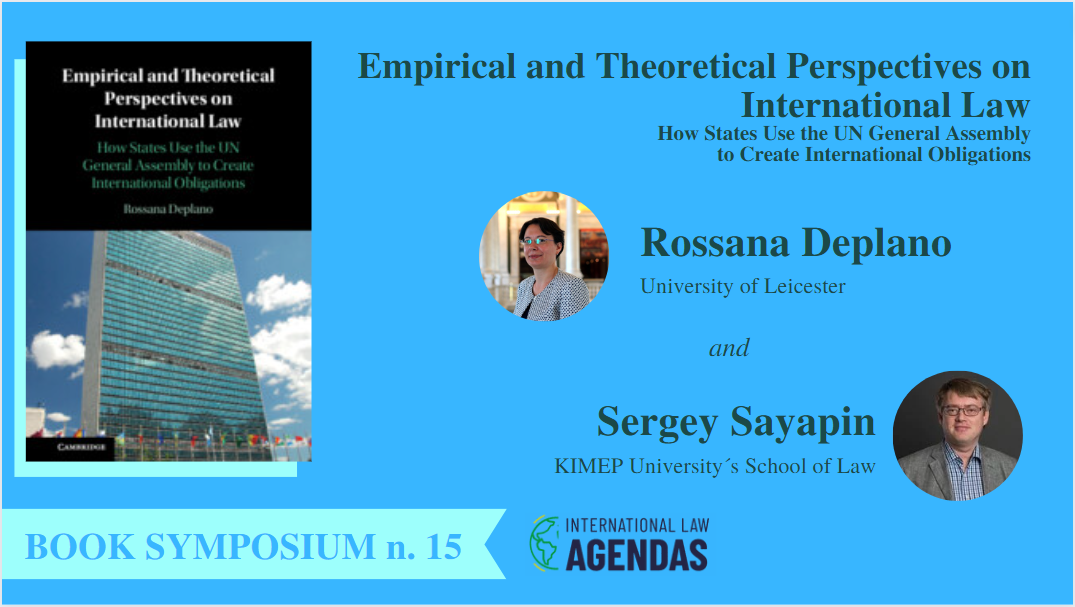It is not easy to review a book which seems to cover virtually all issues within its subject area, and to offer answers virtually to all relevant questions. Brilliantly researched and scrupulous in its argument, Dr. Rossana Deplano´s new book on the legal value of the UN General Assembly resolutions (hereinafter Deplano) is precisely such a work, destined to become essential reading in international law courses, and to prompt a scholarly debate for years to come.
My own interest in the subject matter of Dr. Deplano´s book goes back to an article I published in 2015 in response to Russia´s occupation of Crimea, which analyzed the legal value of the General Assembly resolution 68/262 of 27 March 2014. That resolution became the foundation for all subsequent resolutions adopted by the General Assembly in response to Russia´s aggression against Ukraine, and for relevant resolutions adopted by other international institutions and organs. It is hard to deny the binding legal force of at least some provisions in such specific resolutions, since they build on, and reiterate, the fundamental principles of international law such as the prohibition of the use of force against the territorial integrity or political independence of states, and hence “require a higher degree of implementation than [most other resolutions]” (Deplano, p. 4). I submit that in such challenging contexts, the General Assembly is more than merely a forum for discussion. Given that the Security Council – the organ of the United Nations bearing the primary responsibility for the maintenance of international peace and security – often is paralyzed by its permanent members´ right of veto, the role of the General Assembly as a “standard-setting institution” (Deplano, p. 18) in international peacemaking is growing, and its decision-making is reflective of the evolving practices and opinions of individual states and their regional groups with respect to such crucial matters as the use of force, human rights, international responsibility, and the like.
Dr. Deplano´s book is novel not only in that it challenges some traditional tenets of international law but also in its interdisciplinary methodology. A fascinating exercise in empirical legal studies, the book employs, in particular, statistical methods to the study of international law, and contains highly original observations and conclusions. As massive as the task of categorizing “circa 20,000 resolutions covering virtually all areas of human activity” (Deplano, p. 3) adopted by the General Assembly between 1946 and 2018 was, the author shows convincingly in Chapter 1, that “most resolutions of the General Assembly are now adopted by consensus” (Deplano, p. 40). In the same Chapter, the author helpfully explains the General Assembly´s applicable rules of procedure. Statistics on the longest and most contested clusters of restated resolutions adopted in plenary sessions (Deplano, p. 43), as well as on resolutions adopted in the General Assembly Committees (Deplano, pp. 45 – 63), are particularly revealing Based on this empirical analysis, the author concludes that the “degree of autonomy of the General Assembly [from the UN Member States] is not uniform”, and suggests that “the extent to which the resolutions adopted are able to influence state conduct depends on the degree of state commitment to observe them and their subsequent use in practice” (Deplano, p. 66). Such solid qualitative conclusions deriving from comprehensive quantitative data are also present in the next Chapters.
In the subsequent Chapters, Dr. Deplano discusses the legal significance of resolutions at the adoption stage (Chapter 2), within domestic legal systems (Chapter 3), and in international practice (Chapter 4), before making a convincing case, in Chapter 5, for legal obligations deriving only from some General Assembly resolutions. There, Dr. Deplano argues that, in order for the “resolutions or parts thereof” to “give rise to binding obligations under international law”, resolutions must be supported by “global consensus as to their legal significance and effects” (Deplano, p. 201). She explains further that “[c]onsensus does not necessarily require unanimous support by the international community of states”. Instead, she points out, by reference to Ellis, that resolutions creating international law must be able to stand a four-part test, which includes (1) “the degree of support for the resolution ideally, unanimity or near unanimity”, (2) “the language used in the text of resolutions, as it may reveal the intent of states to create legal obligations”, (3) “the analysis of the statements in explanation of vote, which are described as an evidentiary source of states´ expectations as to the capability of resolutions to create new legal norms or changing existent ones”, and (4) “an assessment of the degree of implementation of the resolution” (Deplano, pp. 202 – 203, footnotes omitted). These criteria largely correspond to the relevant positions of the International Law Association, and the Institut de droit international (Deplano, p. 203). This effectively means that “the capability of resolutions to generate binding obligations through usage is, for all practical purposes, limited” (Deplano, p. 204). Relatedly, Dr. Deplano notes that consensus is not necessarily “synonymous with agreement”, because “there are instances of states not opposing the adoption of resolutions for various reasons, including convenience” (Deplano, p. 207). This logic leads the author to the ultimate conclusion to the effect that “resolutions are not in themselves sources of law. They are a source of obligation: moral, political and potentially legal […] As a result, resolutions creating legal obligations turn out to be exceedingly rare” (Deplano, p. 208, footnotes omitted).
Dr. Deplano is to be commended for the depth of her analysis, attention to details, ability to draw qualitative conclusions from quantitative data, objectivity, originality, and quality of argument. Insightful theoretical perspectives on international law emanate from comprehensive empirical data on the practice of the General Assembly since 1946, making the book an unmatched single reference on the topic. I hope the volume will soon become a “modern classic”, and inspire other researchers to analyze, in a comparative fashion, the decision-making practices of other international organs and institutions – for example, of the UN specialized agencies and regional organizations.
—
See Deplano’s response.
Also see Ridi and Barros‘ review
-

Sergey Sayapin LLB, LLM, Dr. iur., PhD [s.sayapin@kimep.kz] is Professor at KIMEP University´s School of Law (Almaty, Kazakhstan).





